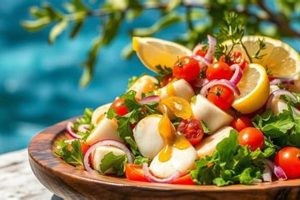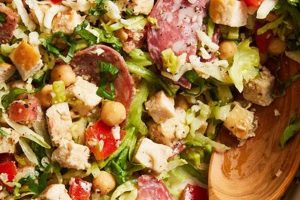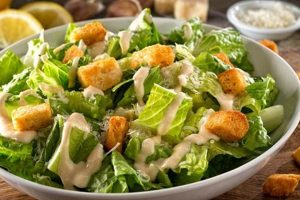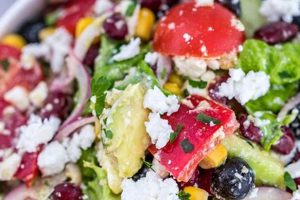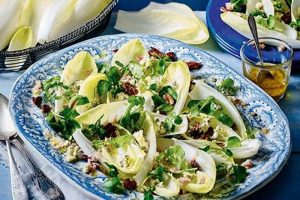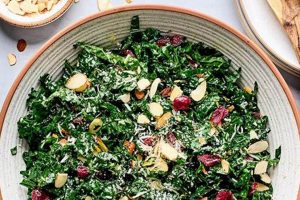Salads rich in dietary fiber offer a versatile and nutritious meal option. These typically incorporate a variety of fiber-dense ingredients such as leafy greens, legumes, whole grains, nuts, seeds, and certain fruits and vegetables. An example might include a spinach salad with chickpeas, quinoa, chopped bell peppers, sunflower seeds, and a light vinaigrette.
Consuming adequate fiber is associated with numerous health benefits. It promotes healthy digestion, helps regulate blood sugar levels, contributes to feelings of fullness, and can assist in maintaining a healthy weight. Historically, humans consumed significantly more fiber than modern diets typically provide. The increasing prevalence of processed foods has led to a decline in fiber intake, making it crucial to find ways to incorporate fiber-rich options, like these salads, into daily meals.
This exploration delves into creating flavorful and satisfying salads packed with dietary fiber. Topics covered include ingredient selection, preparation techniques, dressing recommendations, and creative combinations to maximize both nutritional value and culinary enjoyment.
Tips for Crafting Fiber-Rich Salads
Maximizing the fiber content of salads involves strategic ingredient choices and thoughtful preparation. These tips offer guidance on creating nutritious and satisfying high-fiber meals.
Tip 1: Base with Leafy Greens: Dark, leafy greens like spinach, kale, and romaine lettuce provide a substantial fiber foundation. Consider mixing varieties for a broader nutrient profile.
Tip 2: Embrace Legumes: Chickpeas, lentils, black beans, and kidney beans are excellent sources of both fiber and protein. Rinse canned legumes thoroughly before adding.
Tip 3: Incorporate Whole Grains: Quinoa, farro, and barley add interesting textures and boost fiber content. Cooked grains can be added warm or cold.
Tip 4: Add Seeds and Nuts: Sunflower seeds, chia seeds, flax seeds, almonds, and walnuts contribute healthy fats and fiber. Toasting nuts and seeds can enhance their flavor.
Tip 5: Feature Fiber-Rich Vegetables: Broccoli, Brussels sprouts, carrots, and bell peppers offer additional vitamins, minerals, and fiber. Consider raw, roasted, or grilled preparations for varied flavor profiles.
Tip 6: Choose Fruits Strategically: Berries, apples, and pears offer a touch of sweetness and added fiber. Dried fruits can also contribute fiber, but use sparingly due to their concentrated sugar content.
Tip 7: Dress Smartly: Opt for light vinaigrettes or dressings made with healthy oils, like olive oil or avocado oil. Avoid creamy dressings, which often contain added sugars and unhealthy fats.
By following these tips, individuals can create delicious and nutrient-rich salads that contribute significantly to daily fiber intake. These strategies support digestive health and overall well-being.
Through conscious ingredient choices and mindful preparation, salads become an enjoyable and effective way to prioritize dietary fiber.
1. Ingredient Variety
Ingredient variety plays a crucial role in maximizing the nutritional value and enjoyment of high-fiber salads. Different plant-based foods offer diverse types and amounts of fiber, along with a range of vitamins, minerals, and phytonutrients. A salad composed solely of lettuce, for instance, provides significantly less fiber and micronutrients than a salad incorporating a variety of leafy greens, legumes, vegetables, nuts, and seeds. Furthermore, the variety of textures and flavors resulting from diverse ingredients elevates the sensory experience, making the salad more appealing and palatable. This encourages consistent consumption, thereby promoting regular fiber intake.
Consider a salad combining spinach, chickpeas, chopped bell peppers, sunflower seeds, and a lemon vinaigrette. Spinach contributes insoluble fiber, promoting regularity, while chickpeas offer soluble fiber, supporting heart health. Bell peppers provide vitamin C and antioxidants, sunflower seeds contribute healthy fats and additional fiber, and the vinaigrette enhances flavor. Such a combination provides a more comprehensive nutritional profile than a simpler lettuce-based salad, demonstrating the practical significance of ingredient variety.
Strategic selection of diverse, fiber-rich ingredients ensures not only adequate fiber intake but also a broader spectrum of essential nutrients. This approach supports optimal health outcomes and makes high-fiber salads a more sustainable dietary choice. The inclusion of various ingredients also contributes to culinary appeal, making these salads a more enjoyable and satisfying part of a balanced dietary pattern.
2. Nutrient Density
Nutrient density, the ratio of beneficial nutrients to total calories, is a critical consideration when crafting high-fiber salads. Maximizing nutrient density ensures that these salads contribute significantly to overall health, providing essential vitamins, minerals, and phytonutrients alongside dietary fiber. A nutrient-dense salad offers substantial nutritional value without excessive caloric intake.
- Micronutrient Rich Ingredients:
Prioritizing ingredients rich in vitamins and minerals is crucial for nutrient density. Dark leafy greens like kale and spinach provide vitamins A, C, and K. Colorful vegetables such as bell peppers and carrots offer a range of antioxidants. Incorporating these ingredients ensures the salad delivers a broad spectrum of micronutrients essential for various bodily functions.
- Strategic Use of Healthy Fats:
Including sources of healthy fats, such as avocados, nuts, and seeds, enhances nutrient density. These fats aid in the absorption of fat-soluble vitamins and provide essential fatty acids. However, portion control is crucial, as fats are calorie-dense. A small handful of almonds or a quarter of an avocado contributes healthy fats without significantly increasing caloric intake.
- Limiting Empty Calories:
Nutrient density is compromised by the inclusion of empty calories, such as those found in croutons, sugary dressings, and excessive amounts of cheese. These ingredients contribute calories without substantial nutritional value. Opting for light vinaigrettes, a sprinkle of seeds, or a small amount of low-fat cheese maximizes nutrient density while managing caloric intake.
- Synergistic Nutrient Interactions:
Nutrient density is further enhanced by considering synergistic nutrient interactions. For example, vitamin C enhances iron absorption from plant-based sources like spinach. Combining spinach with bell peppers, a good source of vitamin C, in a salad optimizes iron bioavailability. Understanding these interactions allows for strategic ingredient combinations that maximize nutrient absorption and utilization.
By focusing on nutrient-rich ingredients, incorporating healthy fats judiciously, limiting empty calories, and considering nutrient interactions, salads become powerful tools for delivering a concentrated dose of essential nutrients. This approach elevates salads from a simple side dish to a nutritionally complete and satisfying meal that supports overall health and well-being. Nutrient density, therefore, is a key factor in transforming high-fiber salads into truly health-promoting culinary creations.
3. Flavor Balance
Flavor balance is paramount in crafting palatable and enjoyable high-fiber salads. While prioritizing fiber content is essential for nutritional value, neglecting flavor can lead to unsatisfying meals that discourage consistent consumption. A well-balanced salad engages the palate with a harmonious blend of tastes, promoting enjoyment and adherence to a fiber-rich diet.
- Counteracting Bitterness:
Certain high-fiber ingredients, such as kale or radicchio, can possess a slightly bitter taste. Balancing this bitterness with complementary flavors is crucial. Acidity from citrus fruits or vinaigrettes effectively cuts through bitterness, creating a more pleasant flavor profile. Sweetness, from dried fruits or roasted vegetables, can also mitigate bitterness, while creamy elements, like avocado or a small amount of feta cheese, offer a contrasting mouthfeel that further balances the overall taste. Ignoring bitterness can make high-fiber salads unappealing, hindering efforts to increase fiber intake.
- Highlighting Natural Sweetness:
Many high-fiber ingredients, like roasted root vegetables or berries, offer inherent sweetness. Highlighting these natural sugars can enhance the overall flavor profile. A touch of acidity, from a balsamic glaze or a squeeze of lemon, accentuates the sweetness without adding refined sugars. A sprinkle of cinnamon or nutmeg can complement the sweetness of roasted vegetables, adding warmth and complexity. Emphasizing natural sweetness reduces the need for added sugars, aligning with health-conscious dietary choices.
- Incorporating Savory Elements:
Savory notes add depth and complexity to high-fiber salads, preventing monotony. Umami-rich ingredients, like toasted nuts, crumbled tempeh, or a sprinkle of nutritional yeast, provide a savory foundation. Salty elements, such as olives, capers, or a small amount of feta cheese, further enhance the savory profile. A balanced savory presence prevents the salad from tasting bland, ensuring a more satisfying culinary experience.
- Textural Considerations:
Texture plays a significant role in perceived flavor. A combination of crunchy and soft elements enhances enjoyment. Crunchy vegetables, nuts, and seeds provide textural contrast to softer leafy greens or cooked grains. This interplay of textures stimulates the palate, adding another dimension to the flavor experience. A monotonous texture can diminish enjoyment, even if the flavor profile is technically balanced.
By thoughtfully combining contrasting yet complementary flavors and textures, high-fiber salads become not only nutritionally valuable but also genuinely enjoyable. Flavor balance ensures that increased fiber intake becomes a sustainable dietary change, contributing to long-term health benefits. A balanced flavor profile is therefore essential for transforming high-fiber salads from a dietary obligation into a culinary delight.
4. Textural Contrast
Textural contrast significantly enhances the sensory experience of high-fiber salads. A combination of various textures elevates these salads from simple meals to engaging culinary experiences, promoting enjoyment and encouraging regular consumption. This exploration delves into the multifaceted role of textural contrast in high-fiber salad recipes.
- Crunchy Elements:
Crunchy elements provide a satisfying counterpoint to softer ingredients. Raw vegetables like carrots, celery, and bell peppers offer a crisp bite. Nuts and seeds, such as almonds, walnuts, or sunflower seeds, introduce another layer of crunch. These textural components contribute to a more dynamic eating experience, preventing monotony and stimulating the palate. Toasting nuts and seeds further intensifies their crunch and enhances their flavor.
- Soft Components:
Soft components provide a necessary contrast to crunchy elements. Cooked grains like quinoa or farro offer a chewy texture. Leafy greens, such as spinach or butter lettuce, contribute a delicate softness. Roasted or grilled vegetables, while sometimes retaining a slight crispness, generally offer a softer texture than their raw counterparts. This interplay of soft and crunchy textures creates a more balanced and enjoyable sensory experience.
- Creamy Additions:
Creamy additions introduce a luxurious mouthfeel that complements both crunchy and soft elements. Avocado, a nutrient-rich source of healthy fats, offers a smooth, creamy texture. Small amounts of cheese, such as feta or goat cheese, can also contribute creaminess. These additions enhance the overall sensory experience, making the salad more palatable and satisfying.
- Varied Preparation Methods:
Different preparation methods influence texture. Chopping vegetables into various sizes and shapes adds visual and textural interest. Roasting vegetables intensifies their flavor and often results in a slightly crispy exterior and a tender interior. Grilling vegetables can create a smoky char while maintaining some firmness. These varied preparation methods contribute to a more complex and engaging textural profile.
The strategic incorporation of contrasting textures elevates high-fiber salads from purely nutritional meals to enjoyable culinary experiences. This interplay of textures stimulates the palate, enhancing satisfaction and promoting consistent consumption. A well-executed textural balance is therefore crucial for maximizing both the enjoyment and the health benefits of high-fiber salads.
5. Preparation Methods
Preparation methods significantly influence the nutritional value, flavor, and textural appeal of high-fiber salads. Different techniques affect fiber availability, nutrient retention, and overall palatability. Understanding the impact of various preparation methods allows for optimization of both the health benefits and the sensory experience of these salads.
Chopping vegetables increases their surface area, potentially impacting nutrient loss during storage. However, smaller pieces can make consumption easier, promoting greater intake of fiber-rich ingredients. Steaming vegetables preserves water-soluble nutrients, but may slightly reduce fiber content compared to raw preparations. Roasting, on the other hand, intensifies flavors and creates desirable textures, enhancing palatability. While some nutrient loss may occur during roasting, the improved flavor profile can encourage greater consumption, ultimately increasing overall nutrient and fiber intake. For example, roasted root vegetables, like sweet potatoes and carrots, offer both appealing sweetness and concentrated flavors alongside their fiber content.
The choice of preparation method should align with the specific ingredients and desired outcome. Raw preparations maximize nutrient retention and offer crisp textures. Steaming preserves nutrients and yields tender vegetables. Roasting intensifies flavors and creates appealing textures. Strategic application of these methods ensures that high-fiber salads deliver optimal nutritional value and remain a consistently enjoyable dietary choice. Careful consideration of preparation techniques enables individuals to maximize the benefits of high-fiber ingredients while creating flavorful and appealing meals.
Frequently Asked Questions
This section addresses common inquiries regarding salads emphasizing dietary fiber.
Question 1: How much fiber should one aim to consume daily?
General recommendations suggest 25-30 grams of fiber per day. Individual needs may vary based on factors such as age, sex, and overall health. Consulting a healthcare professional or registered dietitian can provide personalized guidance.
Question 2: Can consuming too much fiber cause digestive discomfort?
Exceeding individual fiber tolerance can lead to gas, bloating, and abdominal discomfort. Gradually increasing fiber intake allows the digestive system to adapt. Adequate hydration is also crucial for optimal fiber function.
Question 3: Are all high-fiber foods suitable for everyone?
Certain medical conditions, such as diverticulitis or irritable bowel syndrome, may require modified fiber intake. Individuals with specific dietary restrictions should consult a healthcare professional or registered dietitian for personalized advice.
Question 4: How can one ensure salads remain palatable while maximizing fiber content?
Flavor balance is crucial. Incorporating a variety of textures, flavors, and dressings helps prevent blandness. Roasted vegetables, nuts, seeds, and flavorful dressings can enhance palatability.
Question 5: Can high-fiber salads contribute to weight management?
Fiber promotes satiety, helping individuals feel full for longer periods. This can contribute to reduced calorie intake and support weight management efforts. However, overall dietary balance and caloric intake remain crucial.
Question 6: Are there specific ingredients to avoid when creating high-fiber salads?
Ingredients high in added sugars, unhealthy fats, and excessive sodium should be limited. Examples include sugary dressings, croutons, and excessive amounts of cheese. Prioritizing nutrient-dense ingredients contributes to a healthier and more beneficial salad.
Understanding the principles of fiber consumption and incorporating diverse ingredients allows individuals to create nutritious, satisfying, and health-promoting salads.
Further exploration of specific high-fiber salad recipes follows.
Conclusion
Exploration of high-fiber salad recipes reveals their significant potential in promoting dietary health. Strategic incorporation of diverse ingredients, attention to nutrient density, flavor balance, textural contrast, and appropriate preparation methods are crucial for maximizing both nutritional value and culinary enjoyment. Understanding these principles allows for the creation of salads that contribute significantly to daily fiber intake, support digestive health, and enhance overall well-being.
Prioritizing high-fiber salads within a balanced dietary pattern offers a proactive approach to health management. Continued exploration of diverse ingredients and creative culinary techniques promises further innovation in this realm, ensuring that high-fiber salads remain a valuable and enjoyable component of a health-conscious lifestyle.

